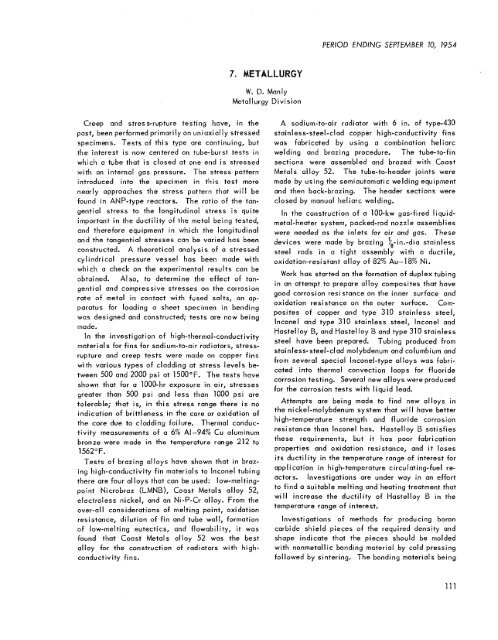ORNL-1771 - Oak Ridge National Laboratory
ORNL-1771 - Oak Ridge National Laboratory
ORNL-1771 - Oak Ridge National Laboratory
Create successful ePaper yourself
Turn your PDF publications into a flip-book with our unique Google optimized e-Paper software.
Creep and stress-rupture testing have, in the<br />
post, been performed primarily on uniaxially stressed<br />
specimens. Tests of this type are continuing, but<br />
the interest is now centered on tube-burst tests in<br />
which a tube that is closed at one end is stressed<br />
with on internal gas pressure. The stress pattern<br />
introduced into the specimen in this test more<br />
nearly approaches the stress pattern that will be<br />
found in ANP-type reactors. The ratio of the tun-<br />
gential stress to the longitudinal stress is quite<br />
important in the ductility of the metal being tested,<br />
ond therefore equipment in which the longitudinal<br />
and the tangential stresses can be varied has been<br />
constructed. A theoretical analysis of a stressed<br />
cylindrical pressure vessel has been made with<br />
which o check on the experimental results can be<br />
obtained. Also, to determine the effect of tan-<br />
gential and compressive stresses on the corrosion<br />
rate of metal in contact with fused salts, on op-<br />
paratus for loading a sheet specimen in bending<br />
was designed and constructed; tests are now being<br />
made.<br />
In the investigation of high-thermal-conductivity<br />
materials for fins for sodium-to-air radiators, stress-<br />
rupture and creep tests were made on copper fins<br />
with various types of cladding at stress levels be-<br />
tween 500 and 2000 psi at 1500°F. The tests have<br />
shown that for a 1000-hr exposure in air, stresses<br />
greater than 500 psi and less than 1000 psi ore<br />
tolerable; that is, in this stress range there is no<br />
indication of brittleness in the core or oxidation of<br />
the core due to cladding failure. Thermal conduc-<br />
tivity measurements of a 6% AI-94% Cu aluminum<br />
bronze were made in the temperature range 212 to<br />
1562OF.<br />
Tests of brazing olloys have shown that in braz-<br />
ing high-conductivity fin materials to lnconel tubing<br />
there are four alloys that can be used: low-melting-<br />
point Nicrobraz (LMNB), Coast Metals alloy 52,<br />
electroless nickel, and an Ni-P-Cr alloy. From the<br />
over-all considerations of melting point, oxidation<br />
resistance, dilution of fin and tube wall, formation<br />
of low-melting eutectics, and flowability, it was<br />
found that Coast Metals alloy 52 was the best<br />
alloy for the construction of radiators with high-<br />
conductivity fin s.<br />
7. METALLURGY<br />
W. D. Maniy<br />
Metallurgy Division<br />
PERIOD ,ENDING SEPTEMBER 10, 1954<br />
A sodium-to-air rodiator with 6 in. of type-430<br />
stainless-steel-clad copper high-conductivity fins<br />
was fabricated by using a combination heliarc<br />
welding and brazing procedure. The tube-to-fin<br />
sections were assembled and brozed with Coast<br />
Metals alloy 52. The tube-to-header joints were<br />
made by using the semiautomatic welding equipment<br />
and then back-brazing. The header sections were<br />
closed by manual heliarc welding.<br />
In the construction of a 100-kw gas-fired liquid-<br />
metal-heater system, packed-rod nozzle assemblies<br />
were needed as the inlets for air and gas. These<br />
devices were made by brazing 1 G-in.-dia stainless<br />
steel rods in a tight assembly with a ductile,<br />
oxidation-resistant alloy of 82% Au--l8% Ni.<br />
Work has started on the formation of duplex tubing<br />
in an attempt to prepare alloy composites that have<br />
good corrosion resistance on the inner surface and<br />
oxidation resistance on the outer surface. Com-<br />
posites of copper and type 310 stainless steel,<br />
lnconel and type 310 stainless steel, Inconel and<br />
Hastelloy B, and Hastelloy 5 and type 310 stainless<br />
steel have been prepared. Tubing produced from<br />
stainless-steel-clad molybdenum and columbium and<br />
from several special Inconel-type alloys was fabri-<br />
cated into thermal convection loops for fluoride<br />
corrosion testing. Several new alloys were produced<br />
for the corrosion tests with liquid lead.<br />
Attempts are being made to find new alloys in<br />
the nickel-molybdenum system that wi It have better<br />
high-temperature strength and fluoride corrosion<br />
resistance than lnconel has. Hastelloy B satisfies<br />
these requirements, but it has poor fabrication<br />
properties and oxidation resistance, and it loses<br />
its ductility in the temperature range of interest for<br />
appl i cation in high-temperature c ircu fating-fuel re-<br />
actors. Investigations are under way in an effort<br />
to find a suitable melting and heating treatment that<br />
will increase the ductility of Hastelloy B in the<br />
temperature range of interest.<br />
Investigations of methods for producing boron<br />
carbide shield pieces of the required density and<br />
shape indicate that the pieces should be molded<br />
with nonmetallic bonding material by cold pressing<br />
followed by sintering. The bonding materials being<br />
111



![Review of Molten Salt Reactor Physics Calculations [Disc 2]](https://img.yumpu.com/21979492/1/190x247/review-of-molten-salt-reactor-physics-calculations-disc-2.jpg?quality=85)













